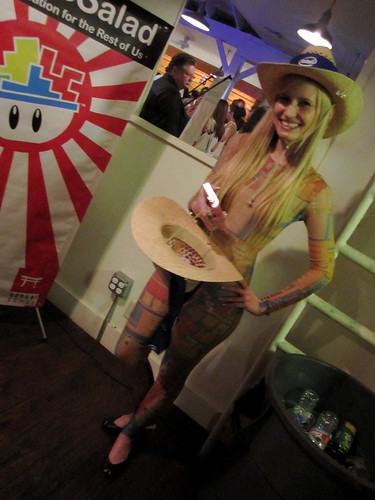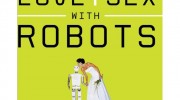
It was the CNN article that finally set me off. I mean, nothing personal to the nice CNN photographers, writers and the guy in charge of CNN I chatted with while drinking beer in my pajamas at 4am in the Hilton lobby as people like Foursquare’s co-founders pretended to backstroke across the marble floor a couple nights ago. There’s nothing wrong with their coverage, but there is everything to be desired. It’s just that the SxSWi coverage in 5 things we learned at South by Southwest is irritatingly superficial and annoyingly uninformed. And that coverage everywhere else is scant. Which is weird for a tech conference that just burst its seams at 15K attendees.
If you read Jolie O’Dell’s piece Why SXSW Sucks, you get a very unfortunate picture, but it adds to a story that I’d like to see told — even if her experience doesn’t necessarily match mine.
Last year SXSWi had grown by 4,000 attendees and had its first queer tweetup meeting; this year it added another 4K and had its first LGBT panel — not that the overall population of tech conference attendees care about such things, but these are markers of growth, diversity and a certain maturity. There were so many panels and talks I kept saying it was “stacked” meaning that there were too many on top of each other, and the sheer volume of attendees made it difficult to see some talks (lines to get in or rooms at overflow capacity), and the other important part of SXSWi, the hallway and party learning, meeting and networking, was incredibly difficult with masses of people. It was great to have lots of people; it was also too big to be useful in the ways we need it to be.
This is a fork in the road for the organizers of SXSW Interactive. They either need to decide if the success of their event hinges on the parties and social events of their conference, with the panels and hard content as a sideshow, or they need to reign in the quality and depth of the panels/talks to ensure future attendance. The keynote interview disaster I describe below is a great example: you just can’t pick a semi-random dude who has never been to SXSW to do an interview with the founder of Twitter based on the fact that he was the one to come up with the idea.
Unlike the CNN article describes, there weren’t masses of new gadgets on the showroom floor. At all. There were booths of crap and more crap, startups whose “sell by” date was practically already expiring when I walked by. There were cool booths where we could say hi to cool companies we recognize, and meet new innovators. But the overall vibe was bizarre. It really was like Dave Chappelle’s Internet In Real Life skit, where you couldn’t walk ten feet without someone shoving schwag in your hand and asking for your contact information; it was human spam and popups in real life. The booth babes were unsettling, and you all know I do like me some booth babes — but they were conspicuous, as if trading off male sweat for mileage. I think the desperation of male geeks is assumed, but miscalculated: just because there were a lot of single guys there who code, it doesn’t mean they have no taste. The most telling part was when the loudspeaker announced that the Dallas Cowboy Cheerleaders were about to make an appearance. I Tweeted snarkily that it was obviously because geeks just love football. But the proof was in the perspiration. The line to meet the cheerleaders: 2 people. The line for free hot dogs: around 40.
Don’t forget the girl who nearly burst into tears when my friend asked her what she was handing out on behalf of a tech company. My friend said, “What’s in the brochure? I just want to know what I’m being handed before I take anything.” The girl almost fell apart. “I… I don’t know what it is. I’m sorry. I have to get someone to tell you.” My friend said that’s okay, but the girl blurted, “I don’t know, they didn’t tell me! I just hand them out. I’m going to go have to ask someone else… I’ll get someone in charge, I’m sorry, I really don’t understand what it is. I don’t know, I’m sorry.” (It was a Microsoft Silverlight handout.)
Overall, I’m hearing that the first day and last day panels were the favorites — though everything in between was at capacity. I have to agree: the few talks I attended in between were run by people who were green as can be (and therefore the title did not match the session’s subject), or it was a panel/talk masquerading as a self-promoting product launch. People really liked our How To Not Be A Douchebag At SXSW panel, and I heard great things about How SciFi Shapes the Internet, Open Science, the Experimental UI Design panel (though sadly it was too full to accommodate everyone), What If Your Phone Had Five Senses?, Battledecks, The Parody Home Companion: DIY Fair Use Determinations, and Mapping and Geolocation: Turnkey Approaches You Need to Know.
It was not all great; joking from the award stage about us being “out of our basements” was just plain insulting and wrong. Once again the keynote interview was a painful bomb — so bad that there was actually a line to leave during the interview. In all honesty, I was in a restaurant around the corner because the value of ‘hamburger with bacon’ was greater than the value of ‘Twitter founder interviewed by some dude’ so I was not actually there. No, I avoided carnage splatter by watching Ev’s interview get murdered on Twitter (on my phone) instead. Once again, someone with the potential to be an interesting subject was interviewed blandly, horribly — by someone we’re now finding out had not only never been to SXSWi, but who didn’t even bother to monitor Twitter during the interview for backchannel feedback. Even I can do this; it’s elementary. Tech scene, where is our Charlie Rose? If only we know some exciting, edgy, experienced media and interview people in the tech scene… oh, wait.
The CNN article and video reminded us for the billionth time that location based services are popular. But no one had anything to actually say about this story: how they are changing the way we make plans in real life, what they do to venues and promoters, how they are used by companies at SXSWi to get buzz going and make parties into promo fests — nor how people were lying to keep crowds away from venues, or how Foursquare was used to grief (humiliate) certain people. For instance, contrived celeb Julia Allison was at one point a location that literally anyone could check into: who was Mayor of Julia? And during the keynote interview I saw that Mark Cuban’s Ego was also a venue. Some of us had fun with it: I think I’m still currently Foursquare’s Mayor of Stuck In The Revolving Doors at the Austin Hilton.
Jolie was right when she wrote, “Too many people, not enough tech.” Usually at this time of the year, there are a million announcements and launches. But — right now is a seriously shit time for startups, period. It’s the climate, and a lot of people I talked to were attending for companies in information-gathering-mode. There were so many attendees that it was difficult to get into venues and people were really spread out. It didn’t help that venues, such as The Ginger Man, would intentionally hold a line for hours for appearances — and the doorman did not dispute this rancid, shitty fact that ruined part of people’s evenings. It made many of us go elsewhere: Jolie complains that the celebs bailed on big parties and that’s certainly true. What I did see celebs do was quite nice, though: instead of the VIP rooms, social media became real life and everyone hung out in non-exclusive places. This behavior proved to me that the so-called web celebs who use and truly understand social media are different than traditional LA-value-based celebrities (Hollywood/porn valley).
You see, they hung out — anywhere. With everyone. While the Hollywood/pornstars see social media as yet another gate by which they can pretend to connect with fans yet keep the riff-raff out, others (like Quentin Tarantino, Kevin Rose) just hung out with everyone. While Ashton Kucher was making my friends look like drooling idiots at a VIP hole, Tarantino was at the Rackspace party and then hit the RVIP to sing kareoke with the nerds. The party was in the Hilton lobby, where I stayed and anyone could join. Foo Fighters in the elevator? Yup. One night we said screw the lines and VIP crap, and threw a late night party in the revolving doors of the Hilton (it was Ed Hunsinger‘s idea), donned party hats, played music, and got everyone to dance in circles for hours. Who joined us at the Hilton anti-VIP? Anyone who wanted to. Hotel staff, friends of friends, Callie Lewis, Dave McClure, Glenda Bautista, some guy named Calcanis, Kevin Rose, CNN, Ustream, Laughing Squid, Scoble, a lot of web celebs, major tech company founders and CEO’s, respected tech blog editors (looking great in party hats), and more. On one hand, who cares? I despise celebrity crap. But people want to know. And It was fun, fun, fun.
I hope to go back next year. I’d like to actually cover it; I intended to cover it for this blog or one of the media outlets courting me right now (specifically about SXSW sex and tech content), but the sex content was so weak I nearly wept. Nothing to report this year. It really was like you could have called all the sessions either ‘Oh My God My Kids Might Find Sex On The Internet’ or ‘The Future of Porn As Told From Five Years In The Past’. It has never been more clear that porn people have no clue about online sex habits + social media, and that porn will continue to be caned by innovation. Granted, many non-sex sites need to get up to speed on adult media consumption as well; it’s my theory that sex-positivity is a key element of business survival online. Of course it all just set me and some devs going in some exciting directions — in addition to having me bring back a ton of innovative ideas for a not-for-profit site I’m advising on delivering sex education on a mass scale. The queer panel was exciting, but left a lot to be desired for me: I didn’t want to know what their blogging policies are, I wanted to know how to encourage queer participation in the very straight tech world, and what I can do as a straight player in the space to foster visibility — and get the tech world to tap into the wealth of knowledge and decades of experience that queer communities have about community management. That’s something many people in tech pretend to have experience about, but do not, and I can tell you that LGBT people have social community conflict resolution skills that straight, fake ‘social media management gurus’ only dream of. Maybe I’ll get my answers next year.
Overall, it was a very good trip for me. It was reliably unexpected.
Related: Imei Hsu’s first SXSWi experience was this year, as told in the post I Am Not That Douchebag.



I’m so sorry that I didn’t hear about the revolving door party! It sounds like it was a blast!
I had a very similar experience, although I too was a SXSWi virgin. I am in the “space” industry, but I can see a lot of similarities. There should be a ton of tech and space crossover, as there is the tech and sex crossover. I have to mirror much of your sentiment about many panels being quite worthless and or misleading. I’m hoping to go back next year and will keep in mind to forget all the rsvp’ing to the “VIP” parties and just make up our own.
I love the idea of a revolving door party!